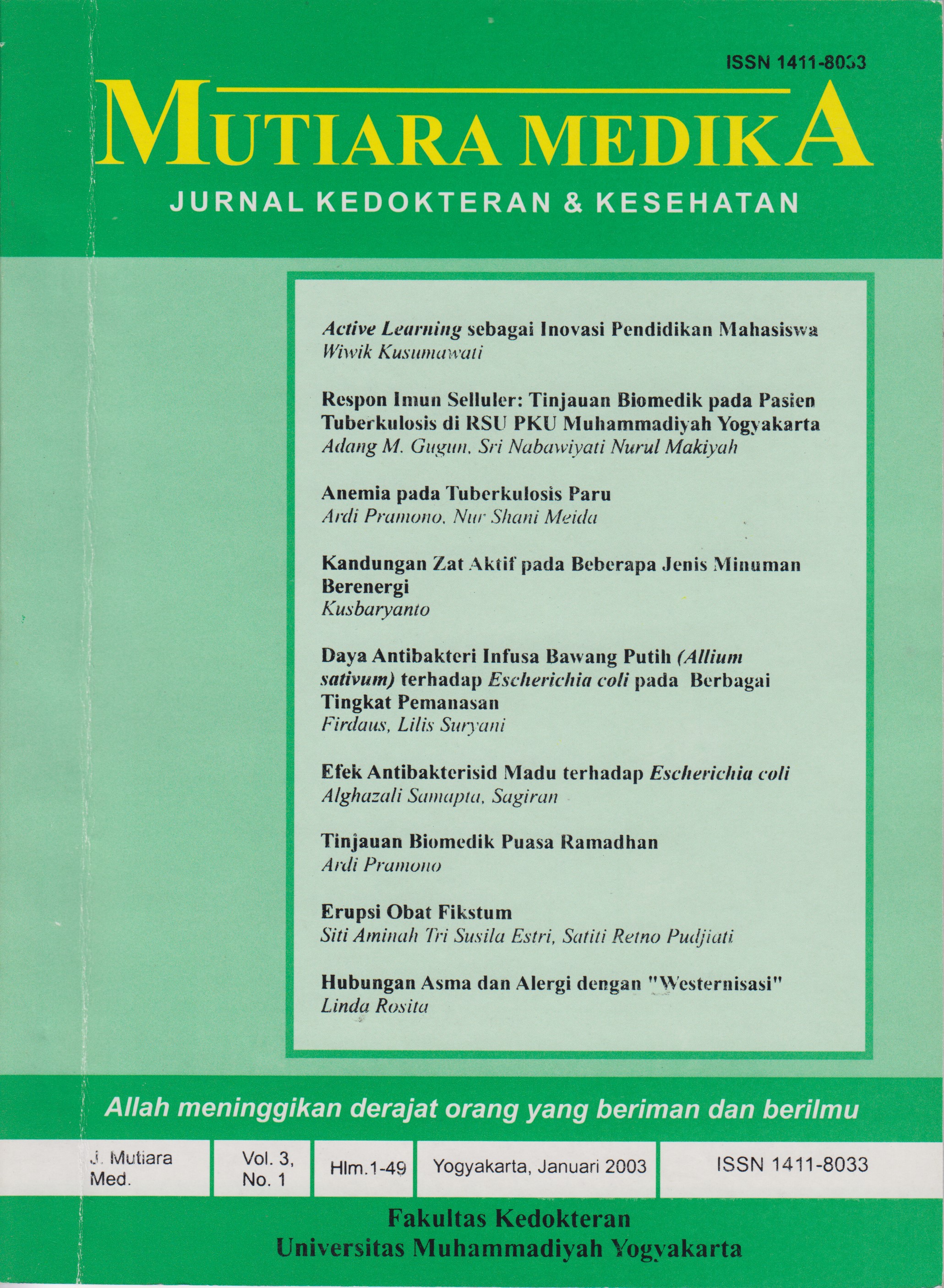Kandungan Zat Aktif pada Beberapa Jenis Minuman Berenergi
DOI:
https://doi.org/10.18196/mmjkk.v3i1.1548Keywords:
zat aktif, minuman berenergi, efek samping, active substances, energy drink, side effectsAbstract
The content of active substances in several kinds of energy drinks which are commonly marketed in public include taurine, caffeine, inositol, ginseng, micotinamide, vitamin B1, vitamin B2 and vitamin B6. In the body, each of those active substances has different function, however in general they can increase energy and vitality. The consumption of an energy drink at a standard dose is quite safe, except in hipersensitivity condition. The side effect of caffeine can arise when it is taken more than 250 mg (5 bottles) all at once. Taurine can also result in side effect, although it is very rare. The consumption of inositol and nicotinamide are to be cautious in diabetic patients, because they can increase blood sugar level. The consumption of piridoxin at 50 mg - 2g for a long period of time can result in side effects of sensoric neuropathy and neu-napathy syndrome.
Kandungan zat aktif beberapa jenis minuman berenergi yang banyak beredar di masyarakat antara lain ialah taurine, kafein, inositol, ginseng, nicotinamid, vitamin B1, vitamin B2 dan vitamin B6. Di dalam tubuh masing-masing zat aktif tersebut punya peran berbeda-beda, namun secara umum akan meningkatkan energi dan vitalitas tubuh. Konsumsi minuman berenergi dalam dosis normal cukup aman,kecuali ada hipersensitifitas. Efek samping bisa muncul dari kandungan kafein apabila SsEEKimsi melebihi dosis 250 mg(5 botol) sekaligus, bisa juga muncul dari kandungan taurine meskipun sangat jarang terjadi,sedangkan dari kandungan inositol dan nicotinamide perlu waspada bagi penderita penyakit diabetes melithus karena bisa menaikkan kadar gula darah.Dari kandungan piridoksin konsumsi jangka panjang dengan dosis antara 50 mg-2g dapat menyebabkan neuropati sensorik dan sindroma neuropati
References
Anonim (2002) Taurine, (http://www.sbwisc.com/ingredients/taurine.html)
Anonim (2002) Taurine, (http://www.thewayup.com/prducts/0256.htm)
Langley, ZL (2002) Taurine and Epilepsy (http://www.indiana.edu/-pietsch/zoe-taurine.html)
Ganiswama dkk(l 995) Farmakologi dan Terapi,bagian Farmakologi Fakultas Kedokteran Universitas Indonesia, Jakarta
Anonim(2002) B+ Energi Drink, (http://www.biosynergy.coiWbplus.htm)
Murray et al( 1996) Biokimia Harper, penerbit buku kedokteran EGC, Jakarta.
Downloads
Published
Issue
Section
License
Copyright
Authors retain copyright and grant Mutiara Medika: Jurnal Kedokteran dan Kesehatan (MMJKK) the right of first publication with the work simultaneously licensed under an Attribution 4.0 International (CC BY 4.0) that allows others to remix, adapt and build upon the work with an acknowledgment of the work's authorship and of the initial publication in Mutiara Medika: Jurnal Kedokteran dan Kesehatan (MMJKK).
Authors are permitted to copy and redistribute the journal's published version of the work (e.g., post it to an institutional repository or publish it in a book), with an acknowledgment of its initial publication in Mutiara Medika: Jurnal Kedokteran dan Kesehatan (MMJKK).
License
Articles published in the Mutiara Medika: Jurnal Kedokteran dan Kesehatan (MMJKK) are licensed under an Attribution 4.0 International (CC BY 4.0) license. You are free to:
- Share — copy and redistribute the material in any medium or format.
- Adapt — remix, transform, and build upon the material for any purpose, even commercially.
This license is acceptable for Free Cultural Works. The licensor cannot revoke these freedoms as long as you follow the license terms. Under the following terms:
Attribution — You must give appropriate credit, provide a link to the license, and indicate if changes were made. You may do so in any reasonable manner, but not in any way that suggests the licensor endorses you or your use.
- No additional restrictions — You may not apply legal terms or technological measures that legally restrict others from doing anything the license permits.






